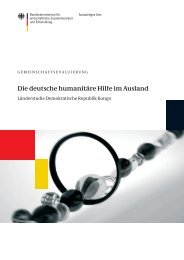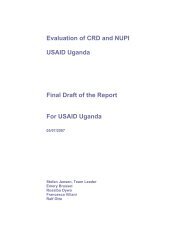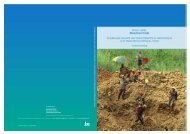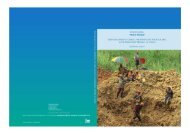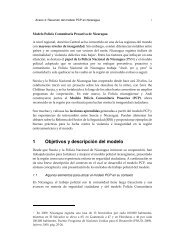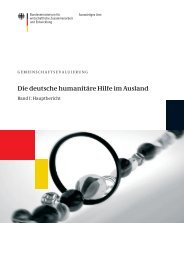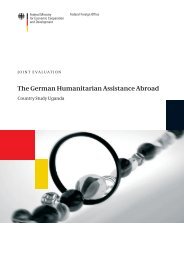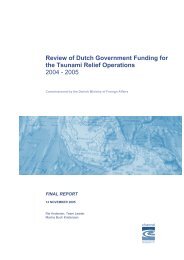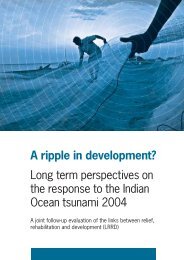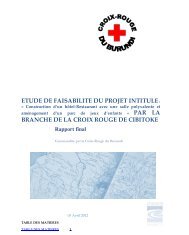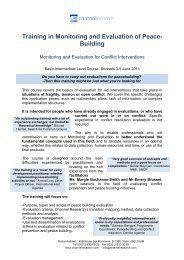Die deutsche humanitäre Hilfe im Ausland - Channel Research
Die deutsche humanitäre Hilfe im Ausland - Channel Research
Die deutsche humanitäre Hilfe im Ausland - Channel Research
Erfolgreiche ePaper selbst erstellen
Machen Sie aus Ihren PDF Publikationen ein blätterbares Flipbook mit unserer einzigartigen Google optimierten e-Paper Software.
provided to United Nations organisations(33 per cent). Non-earmarked funding(about five per cent of humanitarianassistance spending during the evaluationperiod), as promoted within the frameworkof the Good Humanitarian DonorshipPrinciples, and joint financingarrangements (such as country-specificCommon Humanitarian Funds andEmergency Response Funds and also theCentral Emergency Response Fund) arerare.Although the German government is oneof the largest bilateral donors of officialdevelopment assistance (ODA) atinternational level, the share ofhumanitarian assistance in its total ODA issignificantly below the average of otherdonors. German humanitarian assistanceis characterised by a high percentage ofearmarked project funding, using –particularly in the case of the FederalForeign Office – a large number and awide spectrum of German andinternational organisations in a greatnumber of humanitarian crises. As thecountry case studies demonstrate,German humanitarian assistance atcountry level plays only a secondary role.This means that German humanitarianassistance as a whole is very fragmentedand compartmentalised.Relevance and appropriatenessAppropriately, the actors involved inGerman humanitarian assistance use theUnited Nations-coordinated flash andconsolidated appeals. Because of variousl<strong>im</strong>itations, however, these do not offer acomplete overview of humanitarian needsand capacities on the ground. Actors inGerman humanitarian assistance onlyrarely conduct systematic andcomprehensive context and needsanalyses, and often do not sufficientlyspecify the particular needs that are to bemet in the given humanitarian crisiscontext by the proposed measures. Theministries lack the human and technicalcapacities that are actually needed toassess the quality of analyses conductedby their <strong>im</strong>plementation partners. All in all,this form of needs assessment anddecision-making with respect to Germanhumanitarian assistance measures ispatchy and results in a lack of clarity,comprehensibility and transparency in theselection of the financed measures,locations and target groups.The project measures undertaken byGerman humanitarian assistance duringthe evaluation period were, asdemonstrated by the country case studies,for the most part relevant in terms ofmeeting the needs of the affectedpopulation groups and the needs of thevarious areas (both national and regional).German humanitarian assistance, with itsoften standardised approaches, is for themost part appropriate in the way itresponds to sudden natural disasters. Interms of compliance with humanitarianstandards, adjustments need to be madeon a context-specific basis. In theprotracted and complex crises which areoccurring more and more frequently andoften require longer-term, locally adapted,non-standardised approaches, the term,the approaches and the strategicprocedures need to be adjusted. Theapproaches adopted are not alwaysappropriate and are not well enoughintegrated with development cooperationinstruments. There has so far been nodebate in discussions about Germanhumanitarian assistance regarding theconsideration and realisation of the fragilestate concept and the whole-ofgovernmentapproach. The link to nationalpolicies, strategies and programmes is stillinsufficient.Effectiveness and coverageThe results orientation and the formulationof results-oriented objectives of Germanhumanitarian assistance are still notxiii



